Khidrapur Kopeshwar Temple, Poetry Carved in Stone
By Yogita Khandge
Kolhapur in Maharashtra is well known for the Mahalakshmi temple and thousands of pilgrims visit it every year. Another famous pilgrimage center near Kolhapur is Narsobachi Wadi, famous for the Datta temple. When we went to Miraj for some personal work, a friend suggested a visit to the Khidrapur Kopeshwar Shiva temple. This is an ancient Hindu temple known for its architectural excellence at Khidrapur near Narsobachiwadi, supposed to be an architectural marvel. Armed with a little bit of information and lots of curiosity, we set out for our destination.
Contents
Location of Khidrapur Kopeshwar Temple
At Khidrapur, around 60km from Kolhapur, Maharashtra, on the banks of the Krishna River, lies the Khidrapur Kopeshwar (Shiva) temple. For people living in or traveling to Maharashtra, this is one of the top places to visit near Kohlapur. One can combine it with a visit to Narsobachi wadi or Nursinhpur, the famous Datta temple, around 30 minutes drive from Khidrapur.
Khidrapur Kopeshwar is one of the few temples where both the Shaivaites (devotees of Shiva) and Vaishnavites (devotees of Vishnu), have their deity. Vishnu is also in the form of a linga (and known as Dhopeshwar), along with the Shiva linga (and known as Kopeshwar, or the angry God). The height of the Vishnu linga is slightly more than the Shiva linga. It is one of the unique and famous Shiva temples in India.
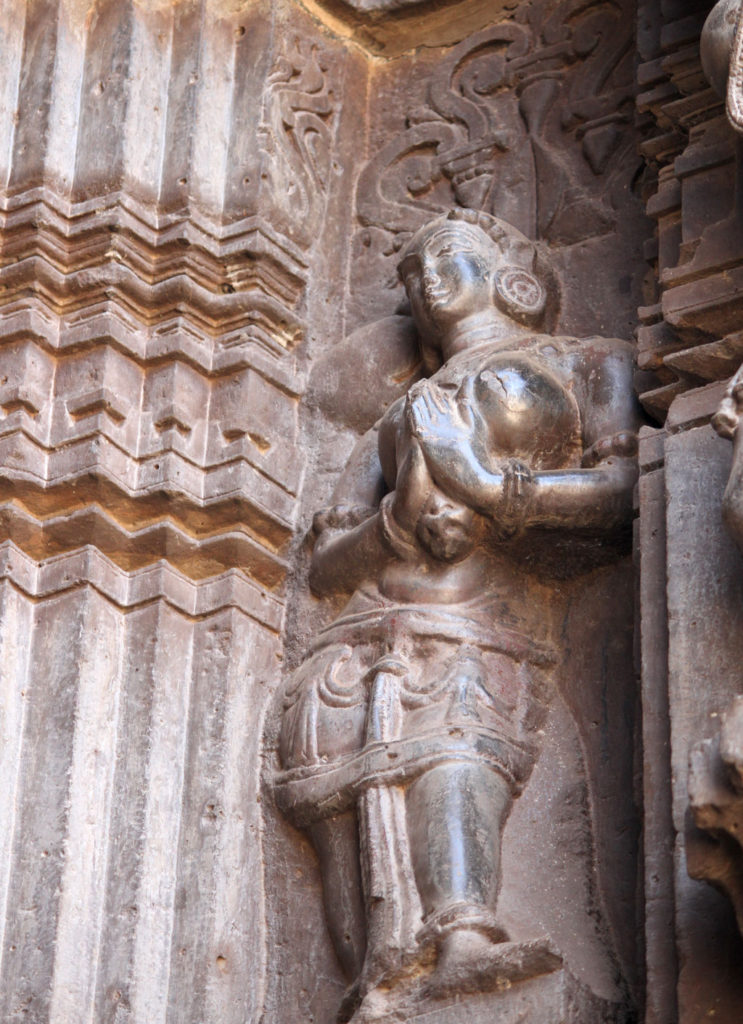
History of Khidrapur Kopeshwar Temple
Circa 609 AD. The Chalukya Empire of Vatapi (present-day Badami in Karnataka) was at its zenith under the rule of the Kshatriya King Pulakeshi II. The Chalukya Empire was an extensive, powerful and economically prosperous kingdom, with a highly developed trade relation with Persia. Culture flourished and artists prospered. To depict this glorious period, construction of an exquisite temple, sheer poetry carved out of stone, started at present-day Khidrapur (earlier it was known as Koppam or Koppad). But prosperity and wealth attracted powerful enemies. A long war with the Pallava King Narsimha Verman led to the death of King Pulakeshi II and the destruction of all that he cherished. One such casualty was the half-constructed temple at Khidrapur. More than 600 years passed with different rulers. Circa 1214 AD. King Singhanadev (or Simhana), said to be one of the greatest Kings of the Yadava dynasty, destroyed King Bhoja II who was ruling this area. He captured all the Shilahara territories, including the area of Kolhapur and Khidrapur. The neglected Khidrapur Kopeshwar temple in ruins, now had a mentor.
There is an early reference to this temple found in an inscription dated 1077 at Yelur (near Bijapur in Karnataka), which mentions Kopeshwar. A stone pedestal mounted east of the temple’s southern door, with carved inscriptions in Sanskrit, mentions 1214 AD as the year when the temple was renovated by King Singhandev of the Yadava dynasty. Khidrapur area was ruled by the Satavahanas (of Paithan), Chalukyas (of Badami), Rashtrakuta (of Latur), Shilahara (of Panhala), Yadava (of Devgiri), Adilshahi (Bijapur), Marathas and lastly by the British, in that order. It is possible that the name Khidrapur was given to the place because of Khider Khan, who had captured the place. His descendents still live Khidrapur. Some researchers believe that the temple construction was started by the Shilahara King Gandaraditya (1108 – 1138 AD).
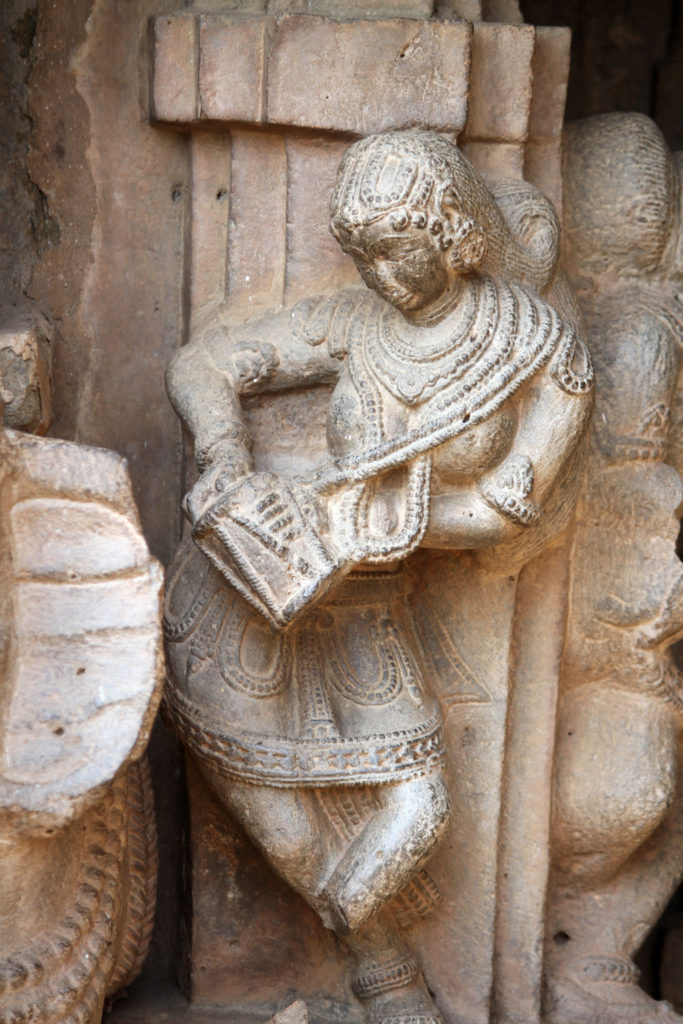
Mythology Surrounding Khidrapur Kopeshwar Temple
A unique feature of this temple is that, unlike all Shiva temples, there is no Nandi (bull) at the entrance. The mythology behind this makes for an interesting explanation. It is believed that King Daksha did not like his daughter Sati marrying Lord Shiva, an ascetic. Once King Daksha organized a huge yagna (a ritual in front of the fire) and intentionally avoided inviting Shiva and Sati. However, an adamant Sati, much against Shiva’s wishes, went to King Daksha’s place at Yedur, (a place South of Khidreshwar) for the yagna. She was accompanied by the bull Nandi. She and her absentee husband (Lord Shiva) were insulted by King Daksha in front of the guests. Sati, unable to bear it, ran into the sacrificial fire and immolated herself. When Lord Shiva came to know about it he was infuriated. He punished King Daksha by severing his head and in his anger, was on the verge of destroying the whole world. Lord Vishnu pacified Shiva whereupon he restored Daksha’s head but with a male goat’s head. It is believed that the furious Shiva, was brought to Khidrapur by Lord Vishnu to calm him down. Hence the temple got its unusual name as Kopeshwar (Kop = wrath, Ishwar = God). This explains as to why Lord Vishnu is in the temple along with a Shiv linga and Nandi is not seen in this temple (Nandi remained at Yedur). Interestingly, there is a statue of a North facing Nandi at Yedur.
The Wonder of Khidrapur Kopeshwar Temple
The outside entrance of the temple is quite simple and gives no indication of the marvel inside. After crossing the outer Nagaarkhana (Drummers Hall), one enters the vast premises of the temple. The walls of the temple are carved out of black stone. The size of the sculptures ranges from 1 inch to 8 feet.
The entire Khidrapur Kopeshwar temple can be divided into four parts. The Swarga mandap (Hall of the Heavens), Sabha Mandap (Conference Hall), Antaral kaksha (intermediate space/ room) and Garbha griha (Sanctum sanctorum), all interconnected.
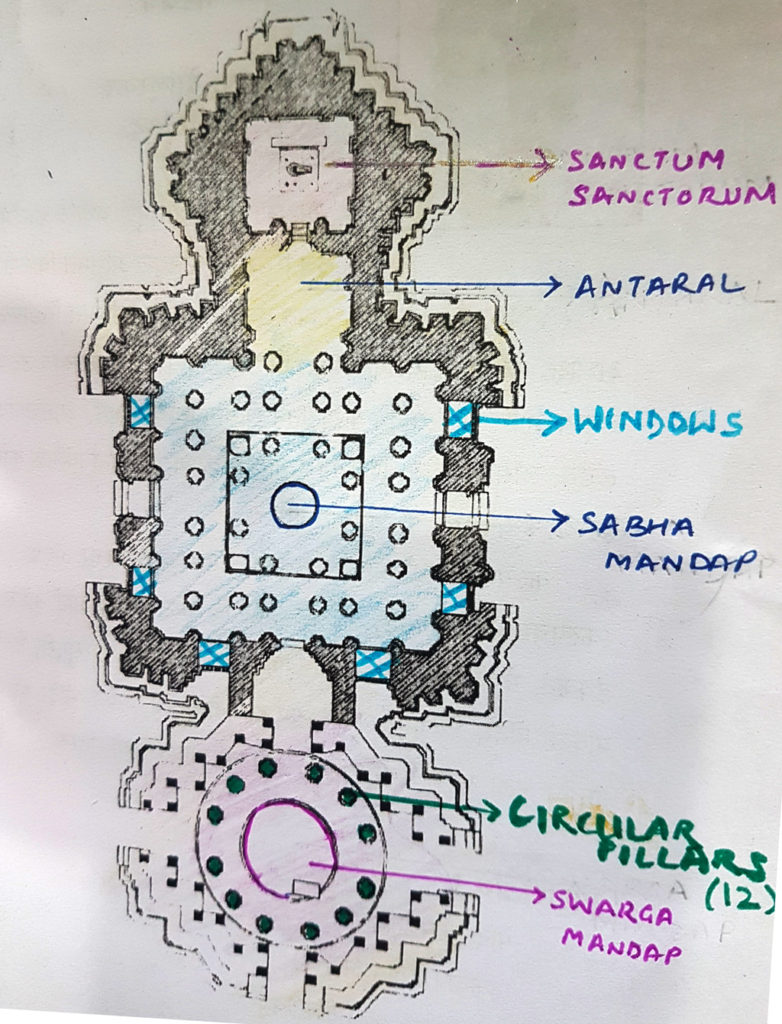
Swarga Mandap in Kopeshwar Temple
The first structure you enter through is the Swarga Mandap. This mandap is round in shape and is constructed with the support of 48 intricately carved rounded stone pillars placed in 3 concentric circles. It has four entrances – one each in the four cardinal directions. The innermost circle is of twelve pillars, surrounded by the second circle of sixteen pillars. The 3rd set of twelve pillars are on a parapet wall and there are eight pillars (2 at each of the 4 entrances). Each of the 48 pillars has been carved in different shapes (round, square, hexagon and octagon) from bottom to top, at different heights. A part of the circular ceiling in the middle (with a diameter of 13 feet) is open to the heavens (Swarga). A beautiful round black stone slab (called ‘Rangshila’) is placed at the bottom of the ceiling. The opening was probably to let out the smoke formed during the yagnas. It also signifies that the opening is a door to the heavens, and the rituals and mantras directly reach the heavens (Swarga) from here. There is a system in place to drain off the rainwater too. While some of the sculptures have been damaged by invaders, one can see sculptures of deities with their consorts sitting behind them on the ‘vahanas’ (conveyance).
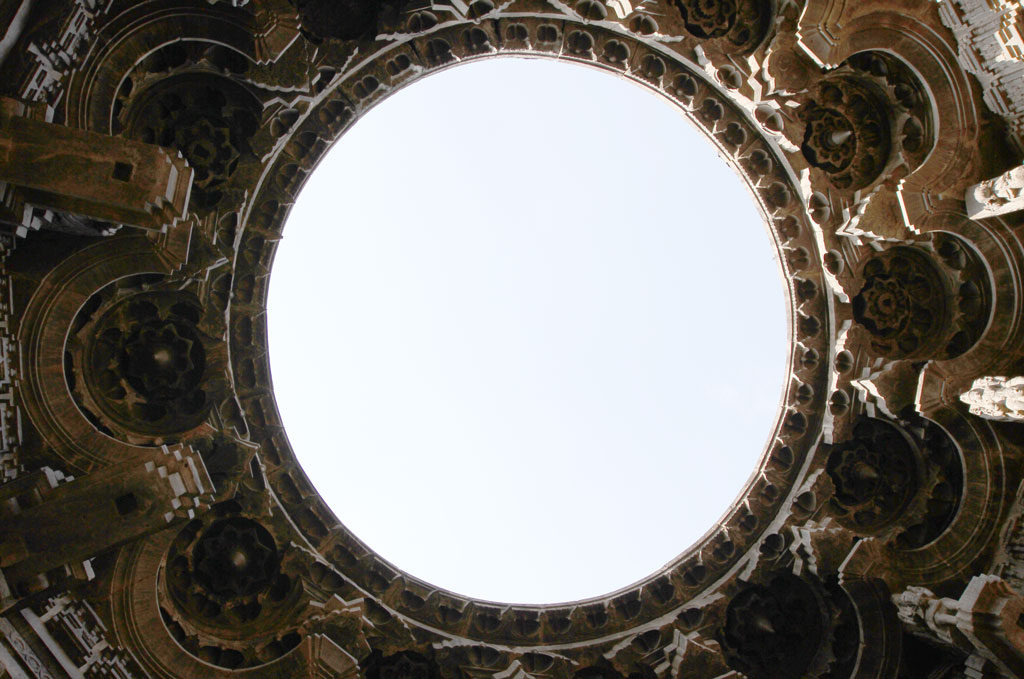
Standing at the center of the Swarga Mandap, one can see the Kopeshwar linga in the Garbha Griha in the front. There is a carving of Lord Brahma on the left and Lord Vishnu on the right. The divine trinity of Bramha, Vishnu, and Mahesh symbolically guard the temple.
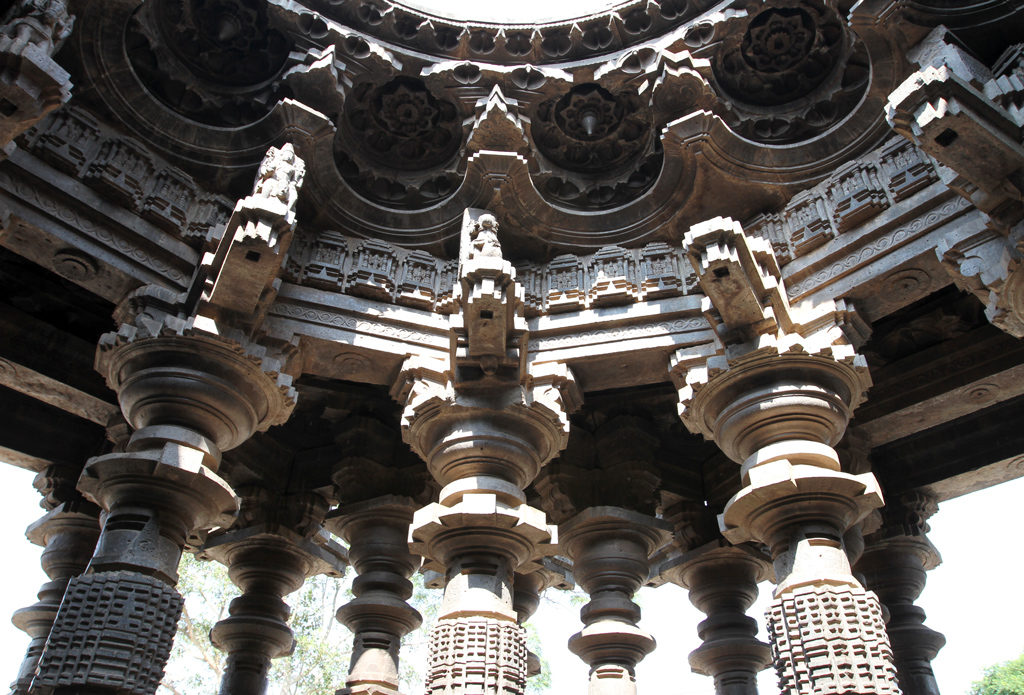
Sabha Mandap
From the Swarga Mandap, we enter the main Conference Hall or Sabha Mandap. The Sabha Mandap has three entrances, the main entrance (Eastern) being from the Swarga Mandap and the other two being on the Southern and Northern sides respectively.
Sixty intricately carved pillars support the roof of this Mandap. While the general architecture is of concentric circles in the Swarga Mandap, the Sabha Mandap has a square form. Twelve pillars are on a square elevation of the Sabha Mandap. Surrounding this, in a square pattern, are twenty pillars. Twenty-eight pillars are in the third square, near the walls. There is a smaller Rangashila here. This is surrounded by four pillars on four sides. The lower portion of the pillars is square and adorned with Kirtimukhas (literally translated as “glorious face”. It is depicted as a fierce demon with huge fangs, and is very common in Hindu temple architecture, especially Shiva temples).
The main door (Eastern) is impressive with its height and structure. There is a row of five mace holding dwarpals (guards) on either side.
The Southern door has a Ganesha on the pelmet. There is a row of seven female dwarpals on either side, along with three male dwarpals.
The Northern door does not have sculptures on the pelmet but there is a row of five male dwarpals, on either side. This unit has different kinds of sculptures on the pillars. Stories from the Ramayana, Panchtantra have been depicted along with the Vishnu avatar (Bhakt Prahlad), Kali Mata, Maruti, Gautam Buddha in the Padmasana pose (signifying the coexistence of Hinduism and Buddhism), etc. The stories from Panchatantra with moral values, are the ones we heard as children (for example, the Talkative Tortoise that lost its life because it opened its mouth while flying with his feathered friends, the Crocodile and the monkey – where the crocodile, influenced by his wife, tries to trap him, etc).
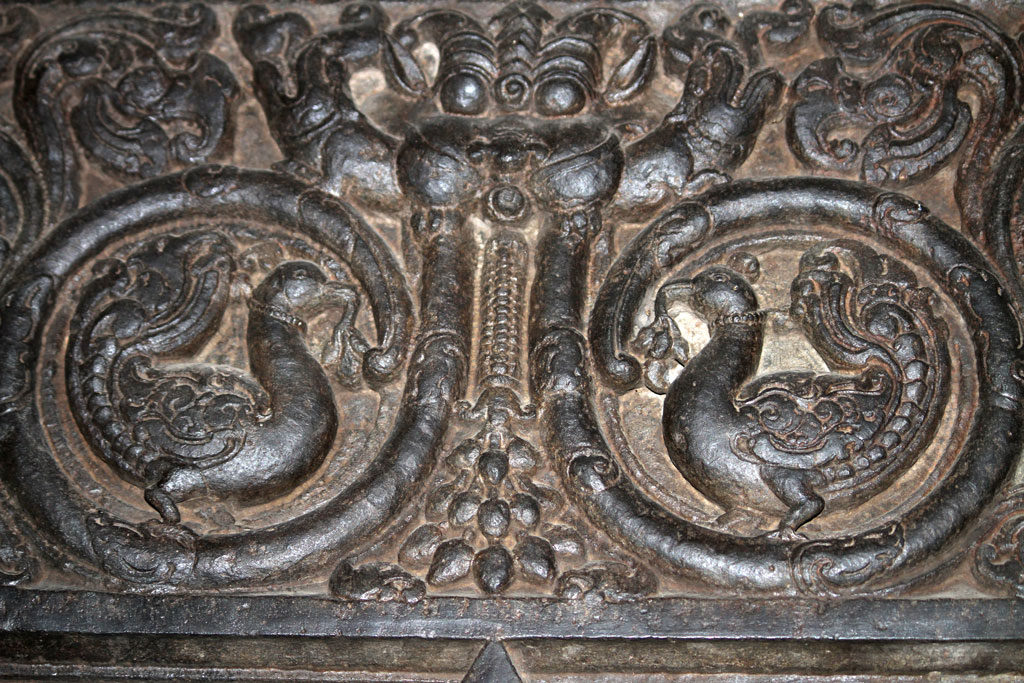
Antaral Kaksha
The space between the Sabha Mandap and the Sanctum is the ‘Antaral Kaksha’ (intermediate space). At the entrance of the Antaral Kaksha are two mace holding dwarapaals’ (guardians) of eight feet height. They are well built and adorned with intricate jewelry. From here, as you enter the conical Sanctum Sanctorum (Garbha Griha), you see a Gajalakshmi on the pelmet. What is special is the presence of the chisel used for making the sculptures, hanging on either side of the pelmet. Both the Shiva linga and the Vishnu linga are present in the Garbha Griha. You first see the Vishnu linga, followed by the Shiva linga. There is an arrangement for doing abhishekha (offering of water/ milk) on the linga. A passage is present to facilitate the flow of water from the abhishekha to the northern side. On the walls are 18 beautiful maidens holding items required for doing pooja. A sense of peace and serenity prevails in the cool interiors of the garbha griha and one can feel the spiritual vibrations there.
Exterior Architecture of Kopeshwar temple
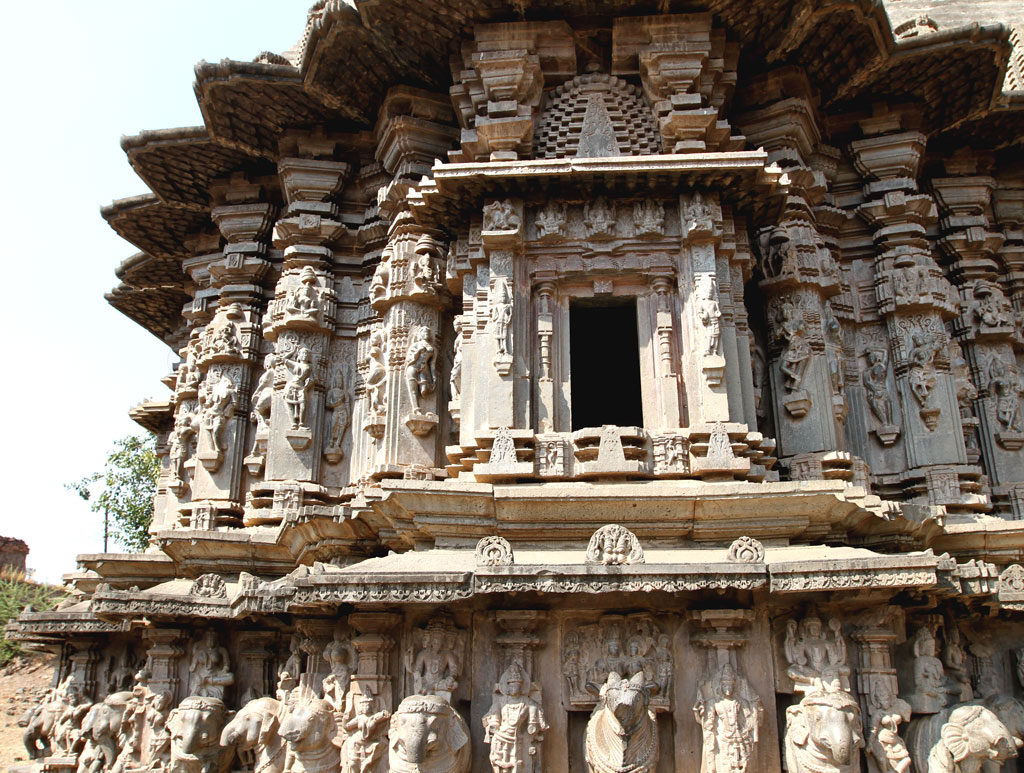
At the base is the ‘Gaja patta’ (Gaja=Elephant, patta = strip), which is a part of the Adhisthan (base or foundation). There are 24 elephants at the base of the Swarga Mandap (of which only 11 are intact). In all, on the exterior are 92 Elephant statues carved at the base, each one different from the other, symbolizing they sustain the structure’s weight. Various deities are astride the elephants. The deities are adorned with beautiful ornaments, clothes, weapons, etc. The elephants are adorned with ornaments, caparisons, and have ornaments and designs on their foreheads and trunks. Above these is the next band of sculptures called ‘Nara patta’ (Nara= man, patta= strip), which has statues of various kinds like dancers, enticers and even a Persian traveler (trade flourished with Persia and modern-day Iran during this period). The clothes and adornments used during those times have been beautifully carved and depicted on these statues. This indicates the presence of an advanced and well-established culture during those times. Different expressions can be seen on the faces of these sculptures. One can see various sculptures of animals like Nandi (bull), Horse, Ram, Varaha (boar), monkeys, tigers, fruits like mango (raw and ripe depicted with a subtle difference), banana, sugarcane, grapes, flowers like lotus, kardal (Canna Indica), birds like swans, peacocks, reptiles like snakes, crocodiles, etc. The jangha (literally translated a thigh’) in the middle portion of the temple which has beautiful sculptures of gods and goddesses.
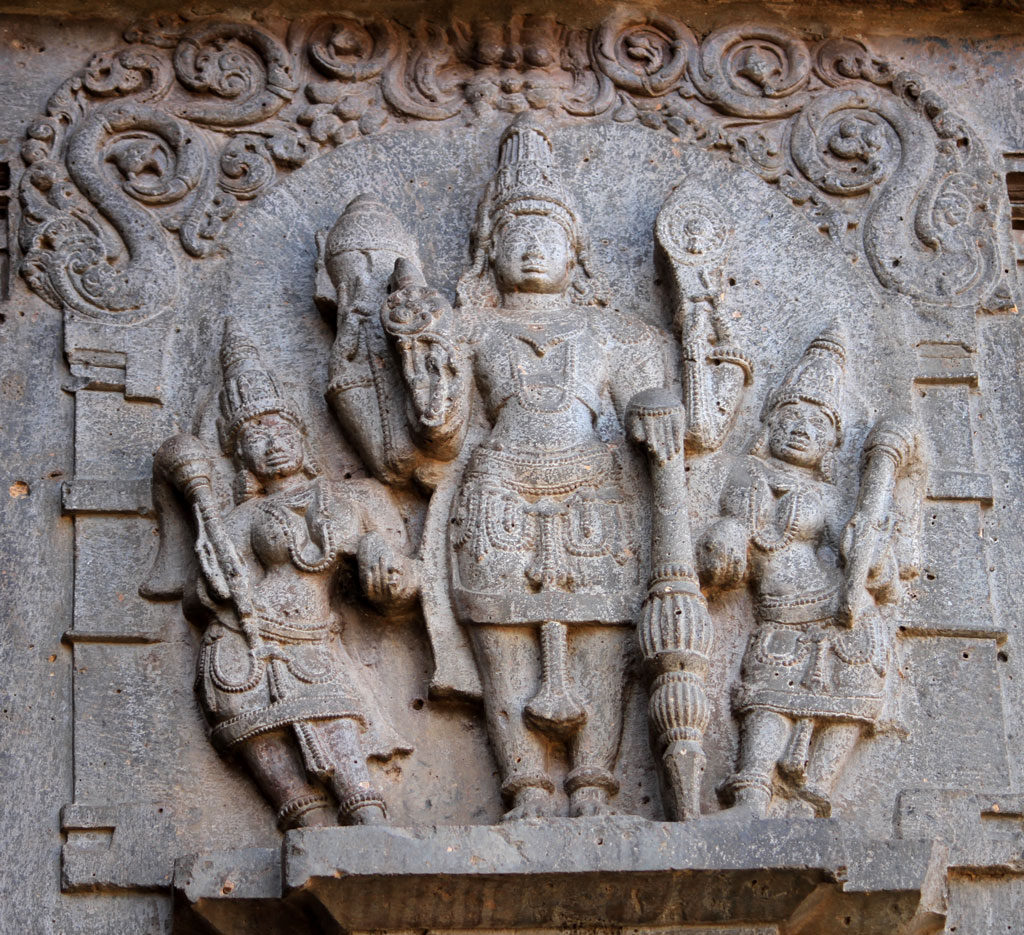
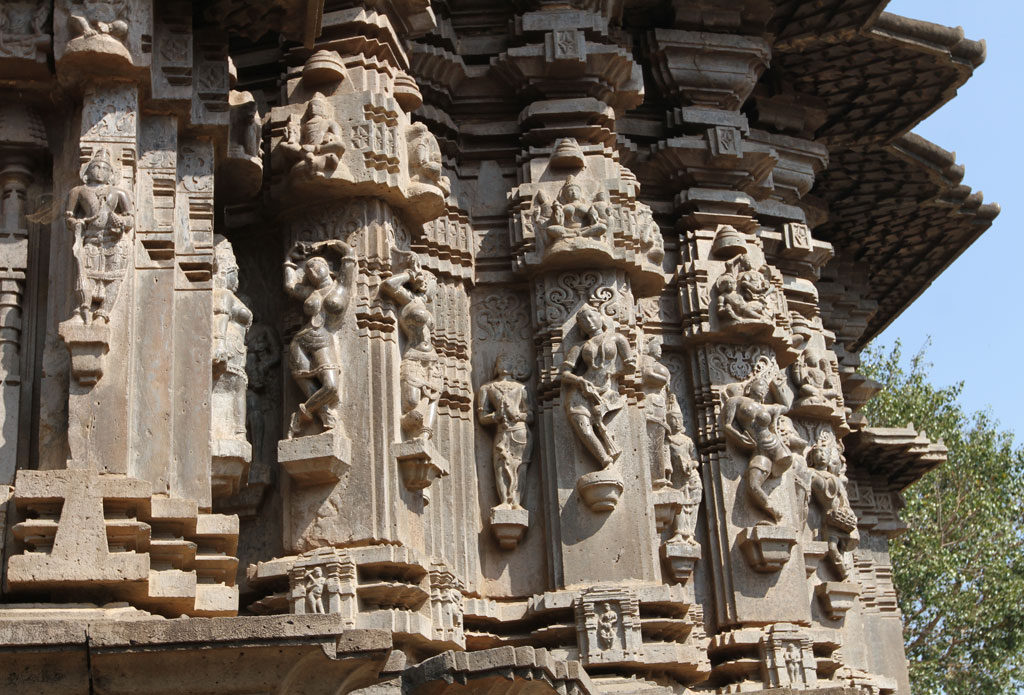
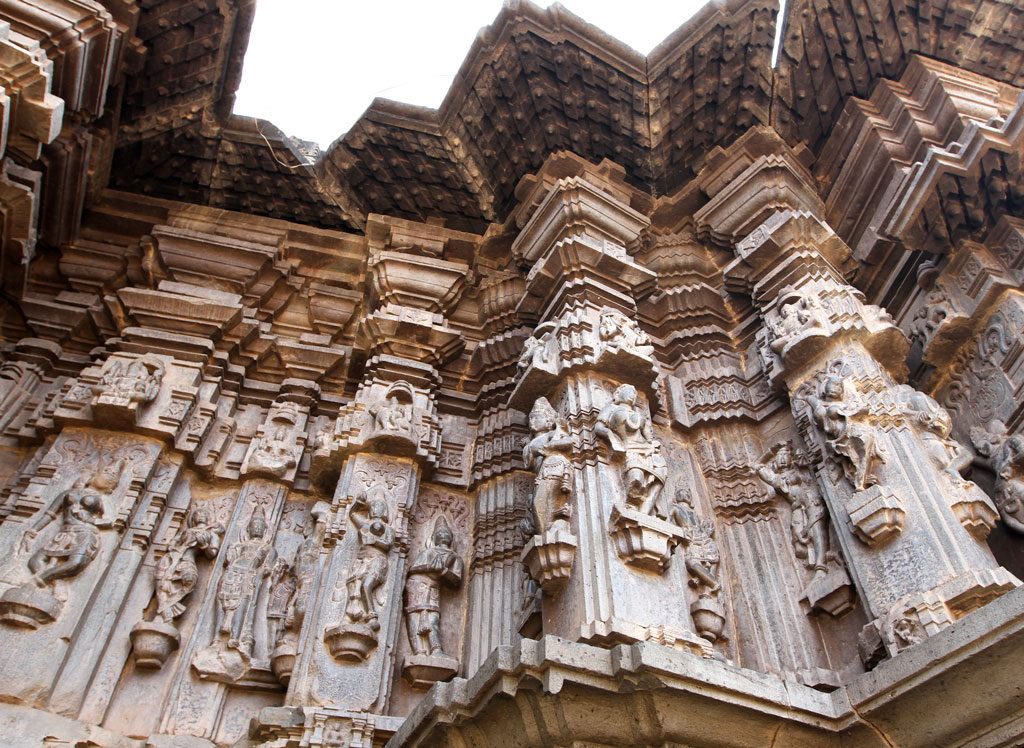
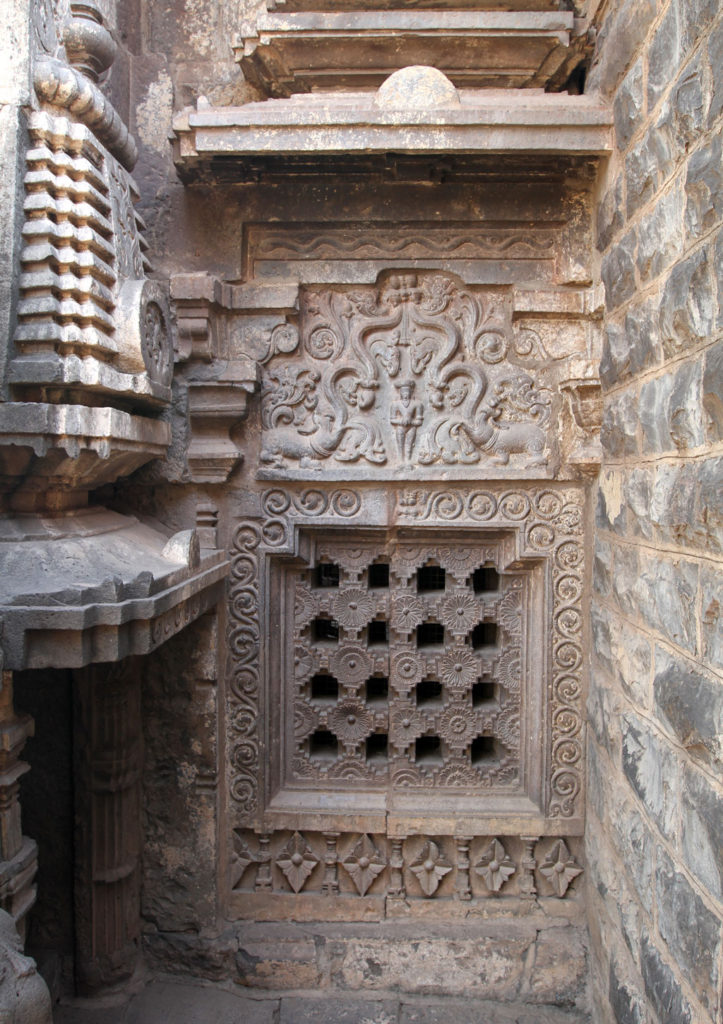
Saptamatruka
It seems that construction of the roof (upper portion) was probably done at a later stage, maybe during the reign of the Yadavas. As you go from the southern side of the Swarga Mandap towards the west, you come across the Southern door of the Sabha Mandap. Near this door can be seen a sculpture of Saptamatruka (a group of seven mother-goddesses) who were also the family deities of the Chalukyas, indicating the connection of this dynasty to the temple. For some reason, the work on the Southern as well as Northern door seems to be incomplete.
Jain Temple at Khidrapur
Further from the Khidrapur Kopeshwar temple, around 200 feet towards the West, there is a beautiful Jain temple, constructed during the same time as the Kopeshwar temple. It is much smaller, the vestibule being twenty-one feet square inside with a small antechamber and shrine, and the outer wall of the temple is star-shaped in Hemadpanti style. It also has beautiful sculptures. The architecture is typically Chalukyan. There is a beautiful four feet tall shrine of Bhagwan Adinath. On the Northern side, there is an exquisite sculpture of a young woman holding a cobra in her left hand. In her right hand is a mongoose, jumping towards the cobra, and she is seen holding the string tied to the mongoose with her fingers.
A more important albeit lesser know Jain temple is the Kulpakji Jain Tirth near Hyderabad.
Mystery of the Black Stone in Kopeshwar Temple’s Construction
An astonishing fact about the Khidrapur Kopeshwar temple is that the black stone used for the construction of the temple is not found anywhere in the vicinity of the location. One of the theories says that the stone was transported from Southern India by using the water channel of Krishna River and then carried to the site with the help of elephants. Another says that slaves were used to carry the stones. Yet another says that there was some divine intervention. But sometimes it is more exciting to let mysteries be…
Kopeshwar Temple Jatra (Fair)
Every year in the month of Magha (January-February) there is a ‘jatra’ of fair at the Khidrapur Kopeshwar temple, attended by about 3-4,000 people. The temple has a lot of devotees visiting it on Mondays (said to be the holy day of Lord Shiva) and Mahashivaratri ( Literally translated as The great night of Shiva, a festival celebrated annually in all parts of India).
Kopeshwar (Shiv) temple is one of the top places to visit near Kolhapur for people who love to experience culture through festivals, food, and tradition.
References and Acknowledgments
Books: Khidrapur chi Mandire-Bharatiyanchi Prachin Thev (in Marathi) by Dr Ramchandra Govind Chothe and Shri Sashank Chothe
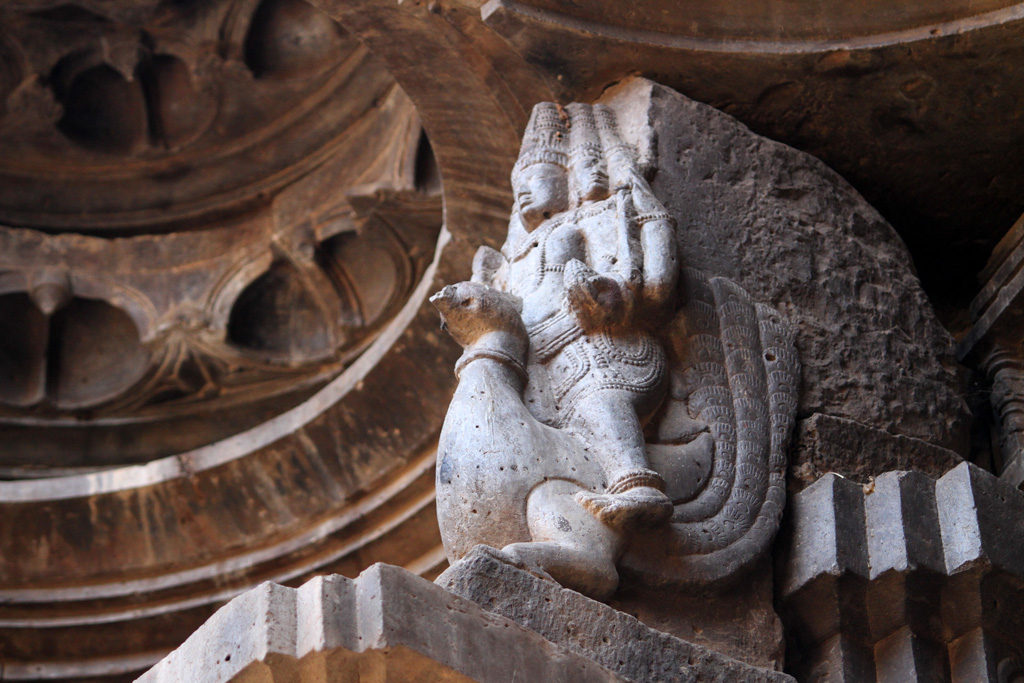
Frequently As Questions
Kopeshwar temple is located in the small town of Khidrapur, which is around 60km from the city of Kolhapur. The best way to reach Khidrapur is to drive or rent a car or taxis from tour operators in Mumbai, Pune or Kolhapur.
The nearest Railway Station is in Jaisingpur (31 km)
The nearest Airport in Kolhapur (60 km)
Because of the proximity, Kopeshwar temple is one of the easy places to visit near Kohlapur.
Kolhapur around 230 km from Pune. If you go from Pune, you can take the Satara- Islampur-Sangli- Jaisingpur- Kurundwad-Khidrapur route or the Satara-Peth Wadgaon-Hatkanangale-Ichalkaranji-Akiwat-Khidrapur route.
Kolhapur is around 500km from Mumbai. It takes around 10 hours by train.
The road distance between Hyderabad to Kolhapur is 541 km.
By Train the distance it is 988 Km.
It takes about 11 hours to reach from Hyderabad to Kolhapur.
Visitors to Kopeshwar use one of several options for food during the trip, such as –
1: Small restaurants and hotels located in the vicinity of the temple.
2: Pack food from Kolhapur, which is a fairly large city and has tons of options to choose from.
3: Get food in Narsobachi Wadi, around 30 minutes drive from Khidrapur.
Narsobachi Wadi a well-known pilgrimage and tourist center (Datta mandir). It has many options to choose from, including local homemade. Pedhas (sweet made from khoya, which is milk boiled till it becomes almost solid), basundi (kind of sweetened, condensed milk) and kavathachi barfi (a sweet made from Wood Apple or Limonia acidissima) from Narsobachi wadi are well known throughout Maharashtra.
The best option is to stay in Kolhapur. As the large city in the area, Kolhapur has a number of good hotels.
Try to avoid the rainy season (when there are heavy rains) if possible, as the village roads may not be in good condition.
Locals in and around Kolhapur and Khidrapur speak Marathi, Hindi and a little bit of English.
Greetings – Namaskaar
Thank you – Dhanyavaad
Help – Madat (incidentally, you can dial 100 – police- for any assistance in case of emergency)
Water- Paani
Food- Jevan
Washroom – English words like toilet, bathroom are commonly used
Restaurant – English word Hotel is commonly used for any eatery
By the way, foreigners need not worry – it is a very safe place to travel, with honest people, and you will always find a local youth, or even school children, who will be happy to understand, translate and help…
Photography is allowed outside the Sanctum Sanctorum which includes the outside structure, gardens, etc. However, photography is not allowed within the Kopeshwar temple, except with special permission.
It is best to take a guide if you really want to understand the finer aspects of the temple. Archaeological Survey of India has a small office with one attendant and 2 helpers. Some of the local guides have good knowledge. They can speak in Marathi, Hindi and to some extent, English. Shashank Chothe – contact no. (+91)8888005889 is one such guide who has also taken training from MTDC (Maharashtra Tourism Development Corporation) and is a treasure trove of information.
What You Experience in Kopeshwar temple
You will experience a sense of history and mystery. A beautiful reminder of the cultural and architectural heritage of ancient India. A sense of seeing and experiencing the heavens in the Swarga Mandap. Peace, serenity, and bliss in the Garbha Griha. The amazing construction is something to be experienced. Explaining the geometry and placement of the walls, the pillars, and the intricacy is difficult, and though I have tried my best to make it simple, including adding a rough sketch of the plan, I guess it may sound confusing at times.
It is sad that many of the sculptures were mutilated by Islamic invaders (probably Aurangazeb in 1702 AD and later Khyder Khan) in the later centuries, though there is no historical evidence of who destroyed what. But what is more saddening is that even now, it faces neglect to a large extent and not much has been done/ being done to preserve its glory.
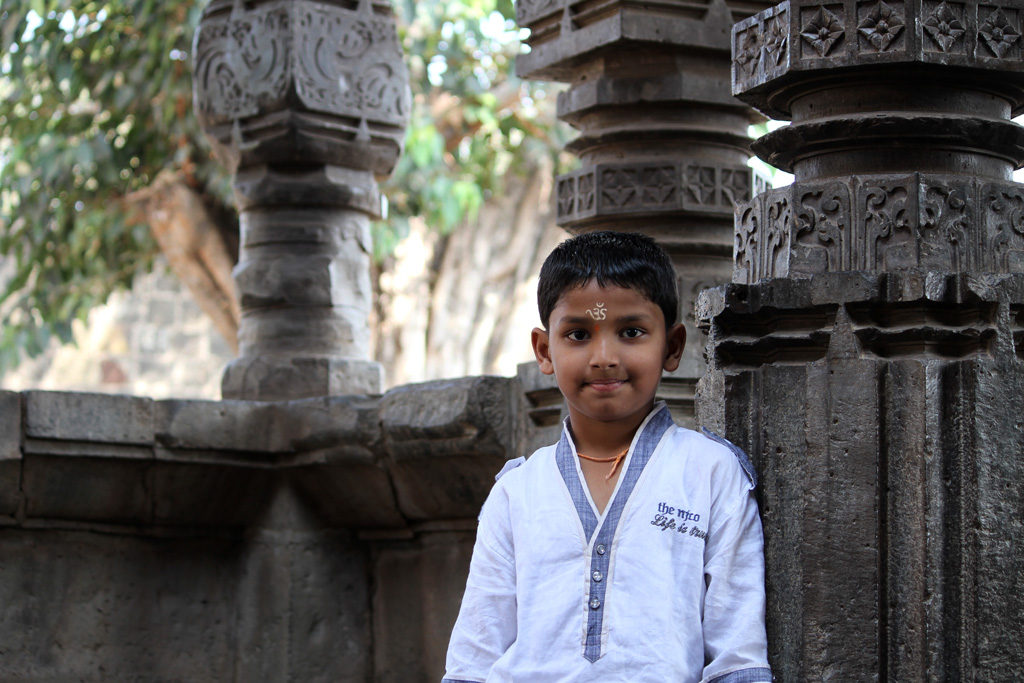
While the ancient traditions live on at Kopeshwar temple, it is definitely one of the top places to visit near Kohlapur. While in Khidrapur area, I hope you’ll enjoy the delectable Marathi cuisine, hospitality, glorious history and traditions of the region.

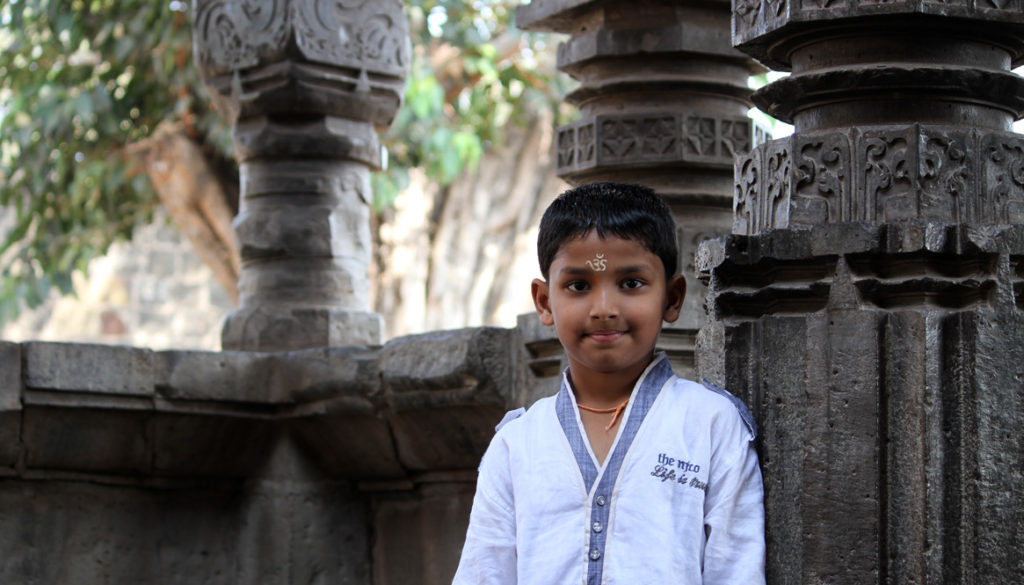
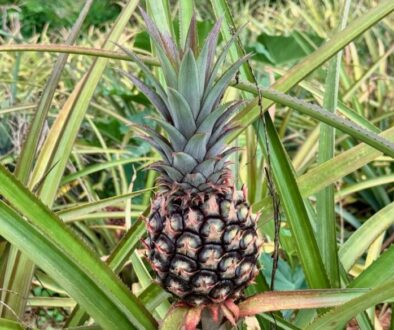
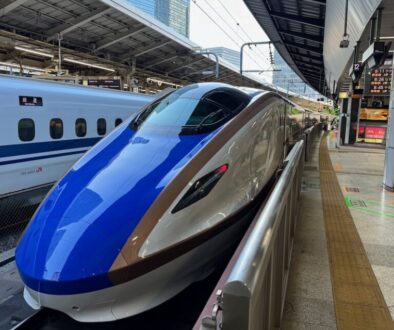
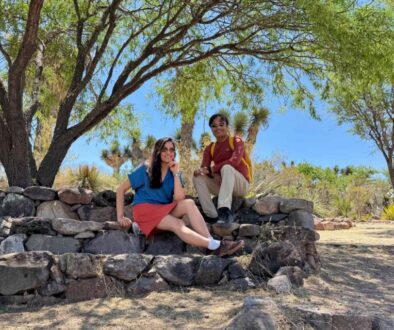

Swati
September 29, 2019 @ 8:58 am
Interesting. Feel to visit once
Yogita
September 30, 2019 @ 8:32 pm
Yes Swati, you must! It’s amazing
Manda
September 30, 2019 @ 3:33 am
Interesting
Bhanu
November 29, 2019 @ 10:28 pm
Who, when and why the temple was tried to destroy?
Yogita
December 16, 2019 @ 11:45 pm
It is believed that the temples were destroyed by Islamic invaders. They in fact destroyed many temples in India probably because they did not believe in other religions and worship of other gods